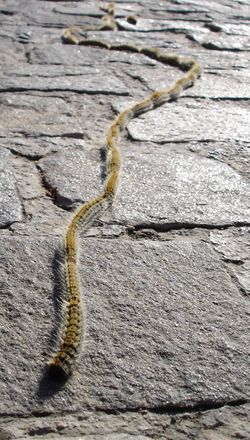Thaumetopoea pityocampa
| Literature database |
|---|
| 132 articles sorted by: |
| • year (descending) |
| • research topics |
| • countries/regions |
| • host plants |
| • list of natural enemies |

Source: Wikimedia Commons
Thaumetopoea pityocampa (Denis & Schiffermüller, 1775) - (pine processionary moth)
The moth is an important defoliating pest of pine trees in Mediterranean countries. Defoliation significantly reduces tree growth, and severe or repeated defoliation can lead to death of the pines. In addition, the hairs of the caterpillars cause strong irritations on the skin and are a health hazard for persons visiting infested pine forests.
The short-lived adults emerge in the summer, do not feed and lay egg-masses on twigs (4-5 cm long) from which the gregarious larvae emerge, 1 month later. The larvae live in silk tents, develop through 5 instars, and descend to the ground during the winter. They pupate in the soil and undergo a diapause until the summer. This diapause may be extended for several years under unsuitable environmental conditions. Apart from these "winter populations", "summer populations" might also occur, with the larvae feeding during the summer months.
| Vernacular names | |
|---|---|
| • Deutsch: | Pinienprozessionsspinner Kiefernprozessionsspinner |
| • English: | pine processionary moth |
| • Español: | procesionaria de los pinos |
| • Français: | processionnaire du pin |
The adults have whitish wings with 2 dark bands across the forewings. Females have a wing-span of 4-5 cm, the males are smaller. The caterpillar may reach a length of about 5 cm and have long whitish or reddish hairs.
Synonyms:
Traumatocampa pityocampa
For details see the respective page in Wikipedia.
- Other images of Thaumetopoea pityocampa (Wikimedia Commons and IPM Images - click to enlarge)










